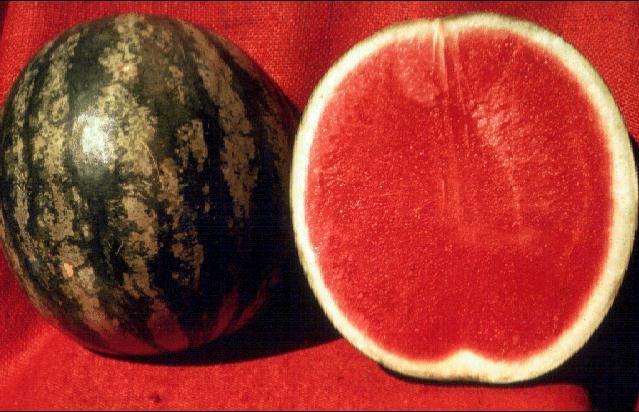Watermelon, Seedless—Citrullus lanatus (Thunb.) Mansf.1
Seedless watermelons are sterile hybrids that develop fruits, but no seeds. The seeds for growing them are produced by crossing a normal watermelon with one that has been changed genetically by treatment with a chemical called colchicine. The seeds from this cross will produce plants that, when pollinated with pollen from normal plants, produce seedless melons.

Credit: James M. Stephens, UF/IFAS
Description
In seedless watermelons, rudimentary seed structures develop, but these are small, soft, white, tasteless, undeveloped seedcoats that are eaten right along with the flesh of the melon. A Japanese scientist developed the technique for producing seedless watermelons. He reported his procedures in 1950. Following is a more technical version of the above explanation.
Culture
The normal watermelon (called a diploid) has 22 chromosomes per cell. By treating seedlings with colchicine, a new plant type called a tetraploid having 44 chromosomes is produced. Then, by crossing a tetraploid with a normal diploid as the pollinator, one gets a triploid (33 chromosomes) seed. This triploid seed produces a sterile hybrid plant that will not reproduce itself (much like the mule or the banana). When flowers of this sterile triploid plant (called the seedless watermelon plant) are pollinated by a normal plant, seedless fruits develop.
Owing to the entire labor-intensive process, the resulting seeds are expensive. Therefore, much care should be given to the culture of the seedless watermelon crop. For this reason, seedlings should be started in peat pots or other suitable transplanting containers. From then on, culture is similar to that for regular watermelons.
Varieties
On Florida trials at Bradenton in 1993, seedless watermelons ranged from 11 to 18 pounds per fruit, and sweetness ranged from 11 to 14 percent soluble solids. The best yielding varieties were 'Supersweet', 'Genesis', 'Millionaire', 'Scarlet Trio', 'Tiffany', 'Tri-X-313', 'Crimson Jewel', 'King of Hearts', and 'Tycoon'.



